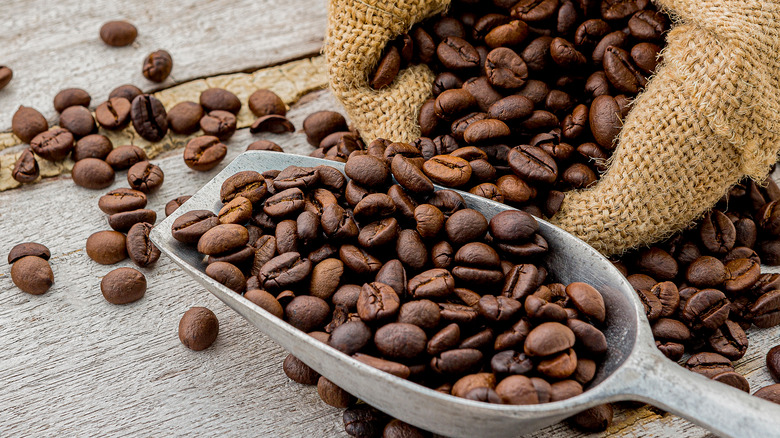The Best Type Of Beans To Use For Your Coffee Tonic
Nursing a warm cup of coffee might be part of your standard morning routine, but it could be time for an update when it comes to your afternoon dose of java. Trade in your mugs for a cool glass of coffee tonic — it's basically the new iced coffee. Fresh, bubbly, and energizing, the beverage is sure to tide you through the rest of your workday. That said, there is a right way to prepare a coffee tonic, and it all stems down to which beans should be used.
Coffee tonic has steadily gained traction, such as Stumptown's cold brew version for the summer. Like a carbonated iced coffee, Coffee Affection shares that all that's required to make one is ice, tonic water, and coffee — espresso or cold brew, you decide. Though some baristas serve the specialty as is, there's also room for creativity, adding a splash of simple syrup or fun garnishes like a citrus wheel, cherry, or herb sprig.
Following the trends toward low-alcohol cocktails and mocktails (via Synergy Restaurant Consultants), coffee-based creations are a great way to add oomph to drinks. Where spirits give a cocktail backbone, Tales of the Cocktail shares that coffee can provide the same structure due to java's bitterness, acidity, and texture. While a coffee tonic is a great way to ease into the vast work of caffeine-spiked tipples, choosing the proper ingredients is essential to ensure that flavors work cohesively, starting with the coffee beans.
Fruit-focused Arabica beans from Ethiopia complement tonic water
Unlike a neutral-tasting seltzer made with carbonated water or salty, mineral-based club soda, tonic water is uniquely different. Revered for its bittersweet quality, MasterClass explains that adding quinine gives tonic water its distinctly crisp and citrusy flavor. To complement this vibrancy, there's one bean that pairs best.
Appealing to the citrusy profile of the tonic, an equally fruity coffee can do marvels, which is why Bon Appétit recommends working with an Arabica bean from Ethiopia. Although the flavor of Arabica beans will vary based on region, Espresso & Coffee Guide explains that the dry-processed beans from eastern Ethiopia have a wine-like profile reminiscent of mainly blueberries and strawberries. With a high level of acidity, these beans naturally counteract the tonic's bitterness while accenting its vibrancy.
Additionally, selecting a single-origin coffee is wise, as you can ensure the maximum expression of that fruity terroir from your coffee beans in your coffee tonic. However, be mindful that depending on which coffee variety you choose, you might need to adjust ratios or even experiment with different types of tonic, per Bon Appétit. Whichever you decide, always use fresh beans and freshly brewed coffee — doing this can take your coffee tonic from good to great!

